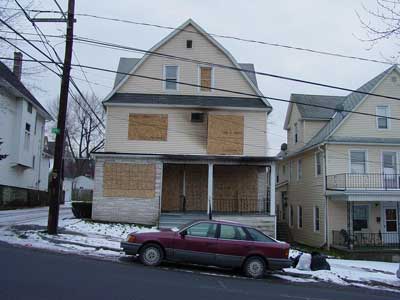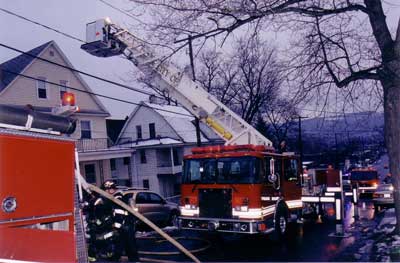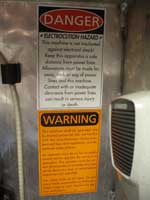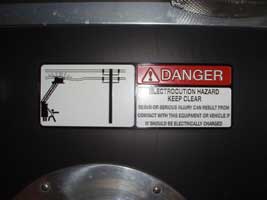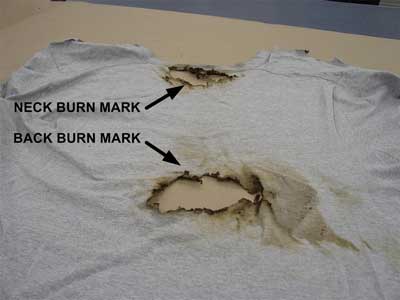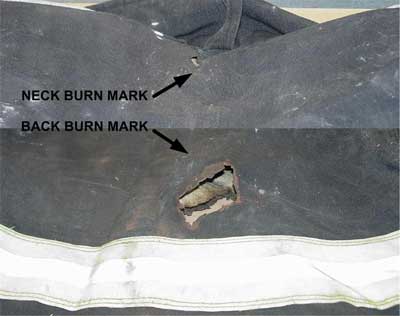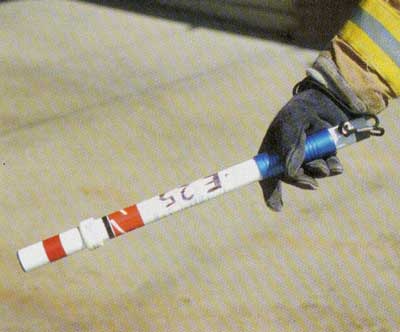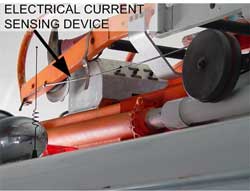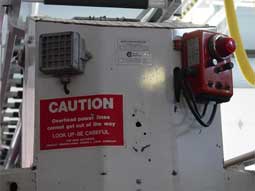Career Fire Captain Electrocuted After Contacting Overhead Powerline From the Platform of an Elevating Platform Fire Apparatus - Pennsylvania
 Death in the Line of Duty…A summary of a NIOSH fire fighter fatality investigation
Death in the Line of Duty…A summary of a NIOSH fire fighter fatality investigation
F2008-01 Date Released: March 11, 2009
SUMMARY
On January 6, 2008, a 40-year-old male career Fire Captain (the victim) was electrocuted after coming into contact with a 12,400-volt overhead powerline. The victim and a fire fighter had been assigned to ventilate the roof of an apartment building and were using an elevating platform fire apparatus to gain access to the roof. The victim was in the process of maneuvering the platform beneath a three-phase overhead powerline when he contacted one of the powerlines with his neck and back. The other fire fighter located on the platform had crouched down just before the contact. After realizing what had occurred, a fire fighter located on the turntable of the apparatus lowered the platform containing the victim and the fire fighter to the ground. The victim and fire fighter were removed from the platform and transported to a local hospital. The victim was pronounced dead on arrival at the hospital. The fire fighter received medical treatment and was later released. Two occupants of the apartment building died as a result of the fire. The following factors were identified as contributing to the incident: fire fighter proximity to energized powerlines; suboptimal incident command; an absence of relevant standard operating procedures; absence of specific periodic training; heightened sense of urgency given civilian occupants; and a lack of verification of the powerline energy state.
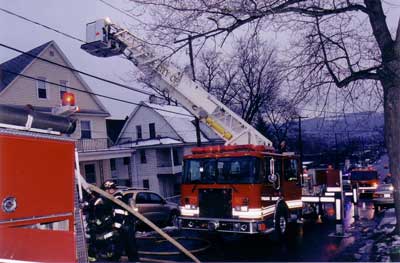 |
NIOSH investigators concluded that, to minimize the risk of similar occurrences, fire departments should:
- develop, implement, and enforce written standard operating guidelines (SOGs) or standard operating procedures (SOPs) for all aspects of fire fighting operations, including procedures for working in proximity to overhead powerlines
- ensure that a distance of at least 10 feet (3 m) is maintained between aerial devices and overhead powerlines
- ensure that a separate Incident Safety Officer, independent from the Incident Commander, is appointed and utilized when incidents escalate in size and complexity
- ensure that fire fighters receive periodic safety training specific to all tasks they are expected to perform
- use proximity warning devices to detect electrical current when working near exposed potentially energized parts (e.g. overhead powerlines) as a secondary/ redundant means of protection
- follow apparatus manufacturer’s safety warnings.
Additionally, NIOSH recommends that as an added safety precaution, fire fighters should always
- consider powerlines as energized and operate accordingly.
Also, the National Fire Protection Association should consider:
- developing safety standards that address work conducted in proximity to overhead powerlines.
INTRODUCTION
On January 6, 2008, a 40-year-old male career Fire Captain died after he contacted a 12,400-volt overhead powerline. On January 8, 2008, the Fire Commissioner from the State of Pennsylvania notified the National Institute for Occupational Safety and Health (NIOSH) of this incident, and requested an investigation of the incident. On January 22-23, 2008, a safety consultant under contract with NIOSH traveled to the fire department and held a meeting with the Fire Chief, Deputy Fire Chief, Captain of Administration, local union president of the International Association of Fire Fighters, and the Director of Public Safety for the city. Interviews were conducted with the local coroner and with the incident commander (IC) and other fire fighters who were at the incident scene. The victim’s and IC’s training records, photographs of the elevating platform fire apparatus and personal protective equipment, and a video of the fire were reviewed. The fire structure, the victim’s personal protective equipment and the elevating platform fire apparatus were examined and photographed by NIOSH.
FIRE DEPARTMENT
This career department consists of 150 fire fighters operating from 8 stations and serving a population of about 75,000 in a geographic area of approximately 26 square miles.
Training and Experience
The department requires new fire fighters to attend an area community college for a 7 week fire fighting course. Employment in the department is contingent upon completing the course and attaining certification as a Fire Fighter Level I from the college. The 7 week course is designed to teach the skills and knowledge needed to qualify as a Fire Fighter Level I based on the requirements in NFPA 1001, Standard for Fire Fighter Professional Qualifications.
The Captain (victim) had about 24 years of fire fighting experience. He had completed the following training: Fundamentals of Fire Fighting, Pennsylvania Department of Labor Apprentice Program (Equivalency Journeyperson firefighter); Hazardous Materials Incidents; Railroad Hazardous Materials; Aeromedical Safety; Vehicle Rescue; Fire Rescue 2; Pump Operations II; Electrical Emergencies; Rope/High Angle Rescue; Foam Firefighting Technician; Arson Awareness/Emergencies; High Rise Firefighting; Natural Gas/Propane Safety; General Fire Service Rescue; Engine Company Operations; Structural Fire Rescue; and Truck Company Operations II (TCO II).
The Incident Commander (IC) had more than 23 years of fire fighting experience. He completed the following training: Urban Search and Rescue (USR) Weapons of Mass Destruction Enhanced Operations; USR Response System Orientation; National Incident Management System; Incident Command System; First Responder Operations Awareness; Propane Gas Practical Exercise; Self Contained Breathing Apparatus Technician; Trench Rescue Operations II; Confined Space Rescue; Fire Rescue 3; Water Rescue; Technical Rope Rescue; Basic Vehicle Rescue Technician; Structural Collapse Technician I, II, and III; Emergency Medical Technician; Emergency Control of Natural Gas; Recognizing and Identifying Hazardous Materials; Railroad Hazardous Materials; Pennsylvania Fire Service Professional Qualifications Board Fire Fighter I and II; Developing Instructional Techniques; Fundamentals of Fire Fighting; National Foams Technician; and Rapid Intervention Team Municipal Departments.
STRUCTURE
The fire building was a three-story residential house of wood frame construction that had been converted into three individual dwelling units, and was built sometime in the 1940’s. The exterior consisted of aluminum siding, and asphalt shingles covered the roof. A three-phase 12,400-volt overhead powerline was located about 35-feet from the A-side of the structure and approximately 25-feet above ground level (see Photos 1 and 2).
EQUIPMENT, PERSONNEL, AND ON-SCENE ARRIVAL TIMES (FIRST ALARM)
Dispatch – 0713 hours
Rescue 1: Officer, chauffer, and one fire fighter-0714 hours
Car 21: Assistant Chief (Incident Commander [IC]) and chauffer-0715 hours
Engine 4: Officer, chauffer, and one fire fighter-0715 hours
Truck 2: Officer (victim), chauffer, and one fire fighter (injured)-0716 hours
Engine 15: Officer, chauffer, and one fire fighter-0716 hours
The apparatus involved in the incident (Truck 2) was a 2002 model, 85-foot mid-mount, elevating platform. Four warning signs were present on Truck 2. A sign was located on the turntable operator’s controls cover and a similar sign was located on the back side of the platform. The signs stated – Danger -Electrocution Hazard – This machine is not insulated against electrical shock! Keep this apparatus a safe distance from power lines. Allowances must be made for sway, rock or sag of power lines and this machine. Contact with or inadequate clearance from power lines can result in serious injury or death. Also, a sign was located on the pump panel on both sides of the apparatus. The sign stated – Danger – Electrocution Hazard – Keep Clear – Death or serious injury can result from contact with this equipment or vehicle if it should be electrically charged. (See Photos 3 and 4).
WEATHER
The conditions were overcast with 10-mile visibility. The temperature was around 38 degrees Fahrenheit, and the wind was calm. There was no precipitation at the time of the incident. The weather did not appear to be a factor in this incident.
INVESTIGATION
On January 6, 2008, at approximately 0713 hours, the fire department was dispatched to a possible working structure fire with potential entrapment. Engine 15 (E15), Engine 4 (E4), Rescue 1 (R1), Truck 2 (T2), and the Incident Commander (IC) responded. All units arrived on scene between 0714 and 0716 hours.
R1’s crew, being one of the first units to arrive on scene at about 0714 hours, gave a size-up of a three-story apartment building with heavy smoke showing (see Photo 1). Incident Command was established at the A-B corner of the fire structure, 1 ¾-inch attack hoselines were laid to the A-side of the structure, supply lines were stretched to the engines, and a water supply established. Forcible entry was made into the structure, and fire fighting and primary search activities commenced. Soon thereafter, fire fighters located an unconscious occupant inside the building on the second floor. The occupant was removed to the outside after the incident, and later pronounced dead at the scene by the local coroner. Note: Sometime later in the incident, another occupant of the building was found on the second floor and also pronounced dead at the scene by the local coroner.
At 0720 hours, a second alarm was struck, and the electric utility company was notified and requested to come to the fire scene. During this time the victim and a fire fighter had made entry into the structure and were searching rooms in the basement. The victim’s low air alarm went off and the crew exited to the outside.
At 0728 hours, E4 requested the roof to be opened, and other crews operating on the 2nd and 3rd floors requested additional hose lines. The electric utility representative arrived on scene and the IC, through face-to-face communication and hand gestures, requested the overhead powerlines be de-energized on both streets. Sometime later the utility representative returned to the IC and told him that the power was cut. Note: Although the power was cut to the apartment building from a secondary powerline on the B-side of the apartment, the primary overhead powerline on the A-side of the apartment remained energized.
Shortly thereafter, in another face-to-face communication, the IC told the victim that electrical power had been cut and that he wanted the roof ventilated. The IC made a decision to provide vertical ventilation through the roof to aid in the search activities still in progress for other occupants. He had determined that ground ladders could not be utilized to access the roof because of the angles and height of the roof. He assigned the victim to ventilate by using the elevating platform on T2 to gain access to the roof. Note: At this time, fire department personnel were still operating in a heightened state of urgency due to the continued search for possible civilian entrapment victims.
The victim instructed the fire fighter that they were going up in the platform. The victim retrieved a chain saw and he and the fire fighter climbed onto the platform of the elevating platform. Using the controls in the platform, the victim swung the platform out of its bed and toward the fire structure, and started extending the boom (see Photo 2). As the platform approached the overhead electrical wires, the fire fighter crouched down onto the platform and then heard an electrical arching (crackling) noise. The fire fighter looked up and saw a wire on the victim’s back (see Photos 5 and 6). The arching stopped as the victim slumped down over the controls and fell back onto the platform.
At this time, a fire fighter who was on the ground retrieving an air bottle from a compartment of T2 and another fire fighter who was located on the turntable of T2 looked up and saw smoke coming from the platform. They informed a nearby officer who then helped direct the movement of the elevating platform while the fire fighter on the turntable lowered the elevating platform. The victim was removed from the platform and carried to the advanced life support vehicle where he was checked for vital signs. No vital signs were detected and he was transported to the local hospital where he was pronounced dead. The fire fighter was also transported to the hospital, evaluated, and later released. At 0828 hours, it was reported that one fire fighter and two civilians were deceased.
CAUSE OF DEATH
The coroner listed the cause of death as electrocution.
CONTRIBUTING FACTORS
The following factors contributed to the incident:
- fire fighter proximity to energized powerlines
- suboptimal incident command
- absence of relevant standard operating procedures
- absence of specific periodic training
- heightened sense of urgency given civilian occupants
- lack of verification of the powerline energy state.
RECOMMENDATIONS
Recommendation #1: Fire departments should develop, implement, and enforce written standard operating guidelines (SOGs) or standard operating procedures (SOPs) for all aspects of fire fighting operations, including procedures for working in proximity to overhead powerlines.
Discussion: Written standard operating guidelines (SOGs) or standard operating procedures (SOPs) enable individual fire department members an opportunity to read and maintain a level of assumed understanding of operational procedures. Fire departments can suffer when there is an absence of well developed SOGs or SOPs. The NIOSH Alert: “Preventing Injuries and Deaths of Fire Fighters” identifies the need to establish and follow fire fighting policies and procedures.1 Guidelines and procedures should be developed, fully implemented, and enforced to be effective. Periodic refresher training should be provided to assist fire fighters in remembering and understanding departmental guidelines and procedures. These SOGs or SOPs should include hazardous energy control procedures. The use of alternating current detectors to verify that powerlines are de-energized should be included in any hazardous energy control procedures developed by fire departments. Note: Alternating current (AC) detectors can detect unshielded AC through snow, ice, and many solid objects. These battery-operated devices are handheld wands similar in size and shape to a police officer’s baton. In the presence of an AC, they emit an intermittent beep. The more rapid the beep, the closer the source is. The detection range (distance from the source at which the wand detects the current) varies with the situation. In general, the higher the voltage, the greater the ranges will be2 (see Photo 7).
Energized overhead powerlines are present at many fire scenes. Accordingly, when fire operations are conducted in proximity to energized overhead powerlines it is of paramount importance that the powerlines be de-energized and that the de-energized status be verified by both the utility company and responsible fire department personnel. In this incident, the fire department did not have any SOGs or SOPs for working safely in proximity to overhead powerlines and mutual verification did not occur. The utility company reported that the powerlines were de-energized, but the fire department did not verify which lines had been de-energized.
Recommendation #2: Fire departments should ensure that a distance of at least 10 feet (3 m) is maintained between aerial devices and overhead powerlines.
Discussion: Aerial device drivers/operators must continually be aware of overhead powerlines. When parking the aerial apparatus, it is just as important to look up as it is to look at the ground. If possible, the driver/operator should spot the apparatus in a position that will require minimum or no maneuvering of the aerial apparatus around obstructions. The goal is always to maintain a distance of at least 10 feet (3 m) between the aerial device and overhead electric lines.3 Additionally, aerial device drivers/operators should be, at a minimum, trained to maintain a 10 foot distance from overhead powerlines; verify that powerlines have been de-energized; recognize hazards associated with operating an aerial device in proximity to overhead powerlines; and understand procedures for emergency situations (e.g. in the event an aerial device contacts an electrical powerline, fire fighters on the ground should never make contact with the aerial device or allow anyone else to contact it).
In this incident, a decision was made to ventilate the apartment building by using the elevating platform on T2 to gain access to the roof. T2 had been spotted in a position that required the aerial device to be maneuvered around a 12,400 volt powerline. Believing the powerlines had been de-energized the victim raised the elevating platform and extended it between the powerlines and communication lines. During this process, his neck and back came into contact with the energized powerline.
Recommendation #3: Fire departments should ensure that a separate Incident Safety Officer, independent from the Incident Commander, is appointed and utilized when incidents escalate in size and complexity.
Discussion: According to NFPA 1561 Standard on Emergency Services Incident Management System, 2008 Edition, “The incident commander shall have overall authority for management of the incident. The incident commander shall ensure that adequate safety measures are in place (5.3.1 and 5.3.2).” This shall include overall responsibility for the safety and health of all personnel and for other persons operating within the incident management system. While the Incident Commander (IC) is in overall command at the scene, certain functions must be delegated to ensure adequate scene management is accomplished.4 According to NFPA 1500 Standard on Fire Department Occupational Safety and Health Program, 2007 Edition, “as incidents escalate in size and complexity, the incident commander shall divide the incident into tactical-level management units and assign an incident safety officer (ISO) to assess the incident scene for hazards or potential hazards (8.1.6).”5 These standards indicate that the IC is in overall command at the scene, but acknowledge that oversight of all operations is difficult. On-scene fire fighter health and safety is best preserved by delegating the function of safety and health oversight to the ISO. Additionally, the IC relies upon fire fighters and the ISO to relay feedback on fireground conditions in order to make timely, informed decisions regarding risk versus gain and offensive versus defensive operations. The safety of all personnel on the fireground is directly impacted by clear, concise, and timely communications among mutual aid fire departments, sector command, the ISO, utility companies and other support groups, and the IC.
Chapter 6 of NFPA 1521, Standard for Fire Department Safety Officer, defines the role of the ISO at an incident scene and identifies duties such as recon of the fire ground and reporting pertinent information back to the Incident Commander; ensuring the department’s accountability system is in place and operational; monitoring radio transmissions and identifying barriers to effective communications; and ensuring established safety zones, collapse zones, hot zones, and other designated hazard areas are communicated to all members on scene.6 The ISO adds a higher level of attention and expertise to help the fire officers and fire fighters. The ISO must have particular expertise in analyzing safety hazards and must know the particular uses and limitations of protective equipment.7 The IC can be assisted in managing on-scene fire fighter health and safety by delegating the function of safety and health oversight to the ISO.
It is of paramount importance that clear communication between the fire department and any electrical utility be established and a set of procedures adhered to before any work is attempted in proximity to an electrical source. Any deviation from the procedures or miscommunication can and has resulted in injury and death. In this incident, when the decision was made to use the elevating platform apparatus to access the roof, the IC could have assigned an ISO the responsibility of assuring that the overhead powerlines were de-energized before the elevating platform was raised. The ISO could have accompanied the utility representative and assured that correct powerlines were de-energized.
Recommendation #4: Fire departments should ensure that fire fighters receive periodic safety training specific to all tasks they are expected to perform.
Discussion: Fire fighters should receive periodic safety training that is specific to the tasks they are expected to perform, such as working in proximity to overhead powerlines. Safety training courses dealing with electrical hazards and measures they should take to avoid the hazards should be completed by fire fighters before they are assigned tasks that may place them near overhead powerlines. This training should be conducted upon initial hire, and periodically thereafter. Applicable safety training should be taught, and the training repeated if necessary, until understood by all members. These safety rules and procedures should be continually enforced by on-scene officers.8 In this case the victim completed numerous safety training courses including Electrical Emergencies. The Electrical Emergencies course was provided by the utility company and included overhead powerline safety. However, the victim completed this course in 1993 and had not taken any further courses dealing with overhead powerline safety.
Recommendation #5: Fire departments should use proximity warning devices to detect electrical current when working near exposed potentially energized parts (e.g. overhead powerlines) as a secondary/redundant means of protection.
Discussion: Proximity warning devices are used to detect the electrostatic field of any alternating current (AC) power line. They provide both audible and visual warning signals to alert the operator and attendant or ground personnel when the boom comes within the proximity of an energized high-voltage power line.9 These devices can help verify that lines are de-energized (see Photos 8, and 9). However, they should not be relied upon as the sole or primary means of verifying whether powerlines are de-energized.
Recommendation #6: Fire departments should follow apparatus manufacturers’ safety warnings.
Discussion: The following safety warning was printed in the manufacturer’s “Trained Engineer’s Manual” for operation of the elevating platform apparatus used at this incident: “Safety Warning! Avoid overhead electrical power lines! The aerial ladder is not insulated. If the ladder comes into close proximity/and or contacts any electrical power source, severe injury or death may occur to the Ladder Engineer, Ladder occupants, and possibly persons in close proximity to any part of the apparatus. Remember, the only safe power line is NO power line.”10 In this incident, the fire department did not verify the utility company’s report that the powerlines had been de-energized. Manufacturers’ warnings for safe operation of equipment should always be followed.
Recommendation #7: Fire fighters should always consider powerlines as energized and operate accordingly.
Discussion: Powerlines can be re-energized or “back fed” by the utility grid system or other means such as portable electric generators. Many powerlines have a recloser (an automatic switch or circuit breaker that reestablishes an electrical circuit after an interruption of service). Therefore, since overhead powerlines can become inadvertently energized, fire fighters should always be operating as if the powerlines were energized (live/hot), and take the necessary precautions such as maintaining a minimum distance of 10 feet.
Recommendation #8: The National Fire Protection Association (NFPA) should consider developing safety standards that address work conducted in proximity to overhead powerlines.
Discussion: The mission of the international nonprofit NFPA, established in 1896, is to reduce the worldwide burden of fire and other hazards on the quality of life by providing and advocating consensus codes and standards, research, training, and education. The world’s leading advocate of fire prevention and an authoritative source on public safety, NFPA develops, publishes, and disseminates more than 300 consensus codes and standards intended to minimize the possibility and effects of fire and other risks.11 Accordingly, the NFPA should consider developing safety standards that address work conducted in proximity to overhead powerlines. At this time, the NFPA does not have safety standards that are relevant to work conducted near overhead powerlines. The U. S. Department of Labor, Occupational Safety and Health Administration, has promulgated work standards that address work from aerial devices in relation to overhead powerlines; however, they do not apply to fire fighting equipment. Examples include: 1910.67(a)(1), “Aerial device. Any vehicle-mounted device, telescoping or articulating, or both, which is used to position personnel”; 1910.333(c)(3)(i)(A) When an unqualified person is working in an elevated position near overhead lines, the location shall be such that the person and the longest conductive object he or she may contact cannot come closer to any unguarded, energized overhead line than the following distances; 1910.333(c)(3)(i)(A)(1) For voltages to ground 50kV or below – 10 feet (305 cm). Also note, 1910.67(b)(3) The requirements of this section do not apply to firefighting equipment or to the vehicles upon which aerial devices are mounted, except with respect to the requirement that a vehicle be a stable support for the aerial device.12
REFERENCES
- NIOSH [1994]. NIOSH alert: preventing injuries and deaths of fire fighters. Cincinnati, OH: U.S. Department of Health and Human Services, Public Health Service, Centers for Disease Control and Prevention, National Institute for Occupational Safety and Health, DHHS (NIOSH) Publication No. 94-125.
- IFSTA [2002]. Fireground support operations, First Edition. Stillwater, OK: Fire Protection Publications, Oklahoma State University: International Fire Service Training Association, p230.
- IFSTA [2000]. Aerial Apparatus Driver/Operator Handbook, First Edition. Stillwater, OK: Fire Protection Publications, Oklahoma State University: International Fire Service Training Association.
- NFPA [2008]. NFPA 1561: Standard on emergency services incident management system. 2008 edition. Quincy, MA: National Fire Protection Association.
- NFPA [2007]. NFPA 1500: Fire department occupational safety and health program. 2007 edition. Quincy, MA: National Fire Protection Association.
- NFPA [2008]. NFPA 1521: Standard for fire department safety officer. 2008 edition. Quincy, MA: National Fire Protection Association.
- International Fire Service Training Association [2002]. Fireground support operations. 1st ed. Stillwater, OK: Oklahoma State University (chapter 10).
- Brunacini [1985]. Fire Command. Quincy, MA: National Fire Protection Association.
- SkyAzul Equipment Solutions, Sigalarm™ – High Voltage Power Line Proximity Warning System,external icon http://www.skyazul.com/english/products/proximity_warning_systems.html
- Apparatus Manufacturer [2002]. Trained Engineer’s Manual, p 36.
- National Fire Protection Association (NFPA), About USexternal icon, http://www.nfpa.org/about%20nfpa.aspx (Link updated 8/12/2013)
- OSHA [2008]. Vehicle-mounted elevating and rotating work platforms, and Selection and use of work practices 29 CFR Part 1910.
INVESTIGATOR INFORMATION
This incident was investigated and the report written by Richard Braddee, safety consultant under contract to the National Institute for Occupational Safety and Health. An expert technical review of the report was provided by Carl E. Peterson, Director, Public Fire Protection Division, National Fire Protection Associationexternal icon, Quincy, MA. http://www.nfpa.org
DISCLAIMER
Mention of any company or product does not constitute endorsement by the National Institute for Occupational Safety and Health (NIOSH). In addition, citations to Web sites external to NIOSH do not constitute NIOSH endorsement of the sponsoring organizations or their programs or products. Furthermore, NIOSH is not responsible for the content of these Web sites.
photos
|
The National Institute for Occupational Safety and Health (NIOSH), an institute within the Centers for Disease Control and Prevention (CDC), is the federal agency responsible for conducting research and making recommendations for the prevention of work-related injury and illness. In fiscal year 1998, the Congress appropriated funds to NIOSH to conduct a fire fighter initiative. NIOSH initiated the Fire Fighter Fatality Investigation and Prevention Program to examine deaths of fire fighters in the line of duty so that fire departments, fire fighters, fire service organizations, safety experts and researchers could learn from these incidents. The primary goal of these investigations is for NIOSH to make recommendations to prevent similar occurrences. These NIOSH investigations are intended to reduce or prevent future fire fighter deaths and are completely separate from the rulemaking, enforcement and inspection activities of any other federal or state agency. Under its program, NIOSH investigators interview persons with knowledge of the incident and review available records to develop a description of the conditions and circumstances leading to the deaths in order to provide a context for the agency’s recommendations. The NIOSH summary of these conditions and circumstances in its reports is not intended as a legal statement of facts. This summary, as well as the conclusions and recommendations made by NIOSH, should not be used for the purpose of litigation or the adjudication of any claim. For further information, visit the program website at www.cdc.gov/niosh/fire or call toll free at 1-800-CDC-INFO (1-800-232-4636).
|
This page was last updated on 03/11/09.

